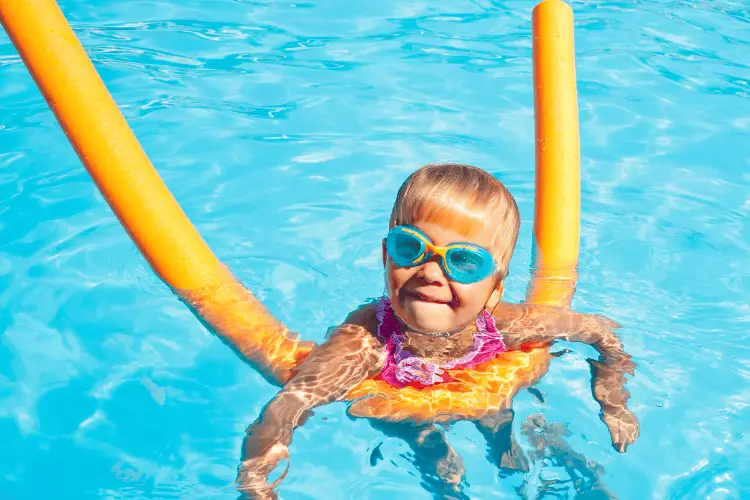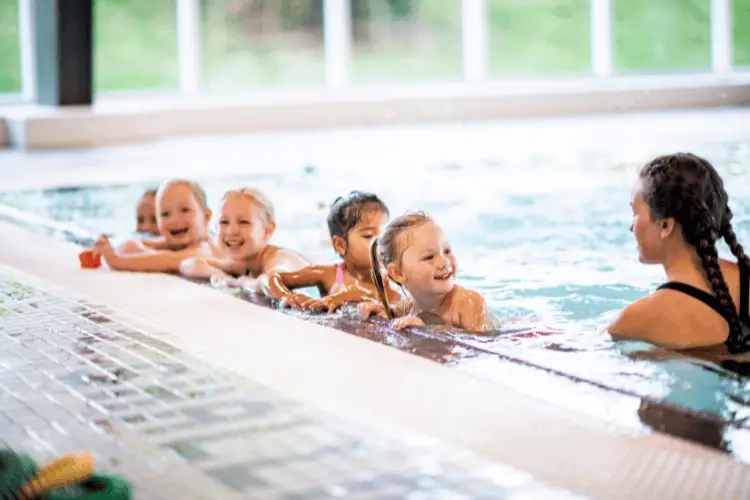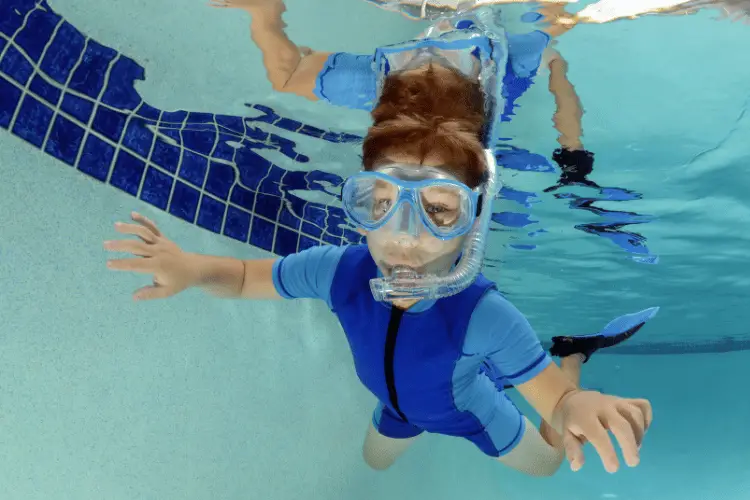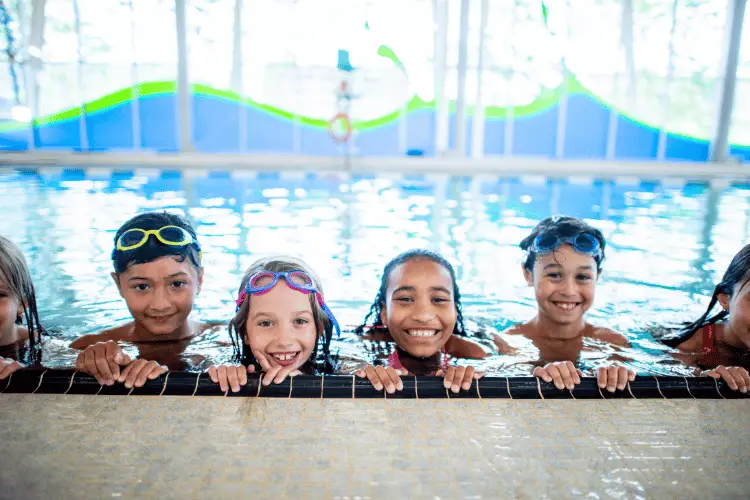When a child doesn’t exercise, they may face issues such as obesity, diabetes, poor bone and muscle health, and lack of stamina. For all these concerns, swimming—or more specifically, in-water exercise—is the perfect answer.
Pool exercises offer around 20 to 30% more mobility than most playground exercises. It’s also more therapeutic, especially with children who demonstrate decreased body awareness.
To make the most out of pool time, I’ve listed some of the best pool exercises for kids to partake in. These exercises target stamina, coordination, flexibility, and cardiovascular fitness!
Swimming Is the Best Exercise for Kids, and Here’s Why
Modern-day children live a sedentary lifestyle: this is a fact.
According to a report published by the World Health Organization, more than 80% of children between ages 11 and 17 don’t get enough exercise. The study paints a depressing picture of a global “pandemic” of exercise insufficiency—one that requires a comprehensive, multi-pronged approach to rein in.
Children aren’t so easily coaxed into physical exercise, especially when entertainment in the form of mobile phones is at arm’s reach.
You need to entice them with an activity that can satisfy their competitive spirit and desire to learn more. That activity is swimming.
Kids are more likely to continue exercising if they’re having fun. Swimming is fun personified; it’s exciting, invigorating, and enjoyable.
Introducing your children to swimming exercises is one of the best ways to put them on the path to a healthy lifestyle. It comes with dozens of advantages, including, but not limited to:
- Improved muscle development
- Improved coordination and balance
- Improved cardiovascular health
- Reduced stress
- Reduced risk of obesity
- Better sleep
- Better cognitive function
- Increased confidence and social skills
- Enhanced strength
Swimming is a low-impact, high-energy sport, making it an excellent option for children with asthma, low stamina, and developmental disorders. It isn’t as strenuous as other physical activities, forgiving on the joints and connective tissues in the body.

Pool exercises like dolphin kicks, jumping jacks, and waiter walks not only boost a child’s cardio fitness but also strengthen all major muscle groups, engaging everything from the arms and shoulders to the legs.
Staying Safe in and Around the Water: Tips for Parents and Swimming Instructors
Whether you’re exercising in a private swimming pool or a public facility, safety should be high on your priorities. Here are some tips to follow when exercising in the pool with kids:
- Invest in a comfortable pair of water shoes for extra traction.
- Exercise in waist- or chest-high water. The child must be able to stand and breathe out of the water at a moment’s notice.
- Accessorize appropriately. Swimming caps, swimwear, water goggles, and other swimming accessories not only add immersion to pool time but also contribute to your little one’s safety.
- Use floatation belts, vests, or styrofoam noodles to add extra buoyancy to the water and encourage learning.
- Just as with any other physical activity, it’s important to stay hydrated while exercising in the water. Let your child drink plenty of water before, during, and after the exercise.
- Avoid too much criticism. The point of exercising in the pool is to have fun. Correct them as you see fit, but don’t be too harsh when your child doesn’t perform up to your standards.
- Praise your child’s efforts. Encouragement boosts confidence and makes your child perform better in their own way.
- Never leave your child alone, even if they’re swimming in shallow water. Water accidents happen quickly and unexpectedly; you should always be around when they’re in the pool.
- Don’t overdo it. Pool exercises shouldn’t be punishing. If your child can’t keep up with the exercise, slow down or try a less vigorous activity. If they appear uncomfortable, stop right away and give them some time to rest.
- Don’t let your kids exercise in a pool heated above 90°F (32°C), as it can make them feel faint. Aim for a water temperature of 83°F to 88°F (28°C to 31°C).
Best Pool Exercises for Kids for Summer Fun
Here are some of the best water exercises to do with kids:
Jumping Jacks
Pool jumping jacks improve a child’s coordination, strength, and flexibility.
They’re best performed in chest-deep water, as the natural buoyancy puts less stress on the joints and muscles.
If your child doesn’t have experience in deeper water, use floaties or pool tubes to help with balance.
To do this exercise, ask your child to stand with his arms out to the side and jump. As he jumps, instruct him to spread his legs shoulder-width apart and raise his arms above his head. Repeat five to 10 times.
Wall Blast Offs
This type of exercise strengthens the lower extremity.
Hold the child underneath his arms and let him float on his back. Then, place his feet on the side of the pool with his knees bent.
Count to three then yell, “Blast off!” As you do, release your hold and have him extend his legs, pushing off them against the wall. Do this exercise three to five times.

Waiter Walks
Waiter walks help with balance, strength, and coordination.
Fill a plastic cup with pool water and place it on a kickboard or a floating flat surface.
Standing on the other side of the pool, ask your kid to “deliver” your drink without spilling the water in the cup.
To ignite your child’s competitive spirit, turn the exercise into a competition. The first kid who reaches you with the fullest cup wins!
Dolphin Kicks
Let your child hold onto the pool’s railings or edge while on their stomach.
Then, ask him to kick his feet like a dolphin or mermaid, with his feet and legs together. If he can’t hold his form, support him by placing both arms underneath him.
Let him kick as hard and fast as he can for an interval of about 20 to 30 seconds, or however long is fitting for their current fitness level.
Walk in Water
Walking in water improves a child’s balance, coordination, cardiovascular fitness, and range of motion.
For this exercise, ask your child to walk from one end of the pool to the next. Start with the shallow end of the pool and make sure that you hold your child’s hand as the water gets deeper and deeper. When it reaches around chest height, walk him back to the starting position.
Do this two to five times. Once your little one gets the hang of it, encourage them to walk around the pool without assistance.
Balancing on a Pool Float
This activity works best for children under the age of six, as it helps improve their core strength and sitting balance.
Gently place your child in the middle of a pool float in a tailor sitting position or criss-cross sitting position.
Give your little one some time to balance on the float. Support him at the trunk or hips if he’s struggling to stay still. Once he has stabilized, slowly let go of the float. The goal here is to let him sit independently without external help.
Log Rolls
This exercise introduces children to rotary breathing for freestyle swimming.
Guide your little one on their back, and instruct them to roll onto their stomach without switching directions.
Support them as needed, just until they’re able to roll onto their stomach without panicking or sinking. Do this exercise three to five times in a row.
Wall Climbs
This exercise strengthens the shoulder belt and the upper body. The goal of this exercise is to enforce independence in climbing and jumping in and out of the pool.
To perform this exercise, position the child’s elbow on the edge of the pool and guide him up and out. Then, ask him to bring forward a bent knee and press his stomach against the floor (if needed), and sit on the side of the pool.
Ask him to do this two to three more times, gradually loosening your support until he’s able to hoist himself up and out of the pool without your assistance.
Earthquake Mattress
In this exercise, a child holds on to a floating mattress as you shake it around. Ask him to hold tight, lest he falls out off the mattress!

Don’t shake it too hard; you don’t want him to fall into the water. Use just enough force to jolt him around, therefore encouraging him to use his strength.
This exercise activates the core muscles and strengthens the legs, arms, and shoulders.
Climb and Jump
If your child knows his way in the water (i.e., can float by himself), introduce this exercise; it’s fun, explosive, and exhilarating!
With your support, ask your child to sit in the middle of a floating mattress. Once he’s stable, instruct him to stand—slowly—on two legs.
While doing so, hold on to the mattress so it won’t jerk around. Then, count to three and yell “Jump!” He’ll jump into the water, feet first.
Do this three to five times.
Crawl With Head Up
This exercise is best performed in shallow water.
While on his hands and knees, ask your child to crawl towards you without moving his head.
Instruct him to keep his chin above the surface of the water.
With this exercise, you’ll be able to observe the movement of his hands and how they navigate the water, allowing you to correct them if needed.
Soldier March
In this exercise, pretend to be a military instructor.
Ask your child to stand up straight in the water and continuously march on the spot.
Extend his arms and legs as far up as possible, moving his arms back and forth to imitate a soldier’s march.
Do this with your little one for one to two minutes.
Pool Noodle Exercise
Pool noodles are among the best pool accessories to use for in-water exercise. With the noodles’ support, children can develop full body strength and awareness in and out of the water.
Bend a pool noodle into the shape of a horseshoe. Ask your child to sit on the horseshoe-noodle without his feet touching the bottom of the pool. The goal here is to have him balance himself in the seated position without falling off the noodle.
If he finds it difficult, switch it up and ask him to sit on the noodle like he’s straddling a horse. Again, his feet need to be off the bottom of the pool and balance without falling off the noodle.
If your kid is swimming with friends, start a pool noodle race. The kids straddle the noodle and swim as fast as they can to the finish line.
Collect the Colored Eggs
This one’s easy but fun, and best performed with a group of kids.
Scatter a dozen or so floating plastic eggs in the pool and ask the children participating to collect as many as they can. The child who collects the most eggs wins!
Feel free to use any other floating toy if you don’t have floating eggs. Just make sure the toys are small enough to grasp in one hand.
To make it more challenging, let the kids use a pool noodle and ask them to swim instead of walking in the water. If their feet touch the bottom of the pool, they’re disqualified!
This exercise is excellent for coordination practice and strengthening the weak hand.
Closing Thoughts
This concludes the article on the best pool exercises for kids!
There’s no better way to spend time in the water than engaging in pool exercises with the kiddos. Through water exercises, kids can move their bodies freely and acquire fundamental sensory and motor processing abilities that can later be implemented out of the water.
The swimming exercises above turn an ordinary family outing into an exhilarating, action-filled day at the pool or beach. Have fun, but remember: safety first!
Even if your child is the next Michael Phelps, he needs your full support in the water to guarantee his safety. Don’t develop an “it won’t happen to me” attitude, as a split second of inattention can lead to less-desirable consequences.


